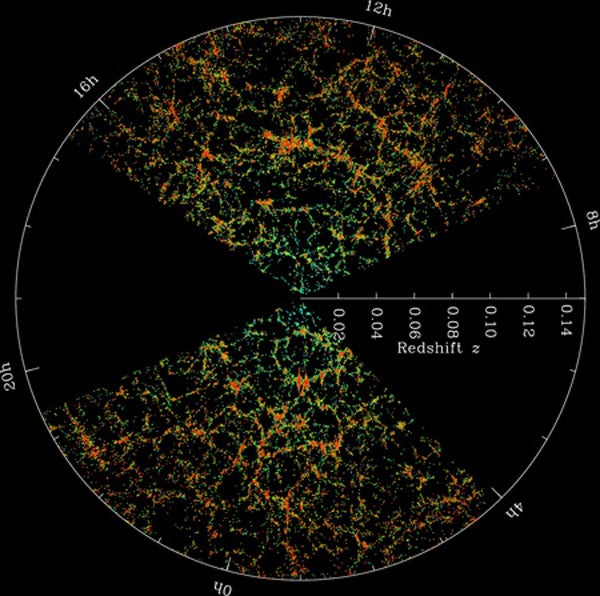The OSU project, led by Chris Orban, focuses on simulations created on the Ohio Supercomputer Center (OSC) systems to simplify and better characterize a subtle dark matter clustering feature. The new model allows cosmologists to gain a more accurate understanding of certain aspects of large-scale structure, such as the effect of the expansion of the universe on the growth of density fluctuations.
“Knowing how the dark matter ‘reacts’ to the expansion of the universe is crucial for learning the most about dark energy and dark matter from large astronomical surveys like the Sloan Digital Sky Survey, of which OSU is a collaborating member,” said Orban. “In particular, there is a subtle clustering feature seen in this data set called Baryon Acoustic Oscillations (BAO), which turns out to be very useful for constraining cosmological parameters like the equation of state of dark energy.”
The oscillations come from fluctuations in the distribution of hot plasma in the early universe; researchers can identify this feature by measuring the cosmic microwave background.
“The BAO signature gets imprinted on the dark matter very early on, but the feature changes over cosmic time, potentially biasing its use as a cosmological tool,” Orban said. “It’s a complicated non-linear problem, and physicists are very fond of simplifying complicated problems to gain a more in-depth understanding. This is exactly what we did for the first time, in our paper, using N-body simulations.”
“For current state-of-the-art astronomical surveys, the main non-linear effects that we investigate in the paper are negligible compared to other sources of error, but next-generation surveys will need to be far more sophisticated in this regard,” said David Weinberg from OSU. “This places the utmost importance on making reliable and precise predictions for these non-linear effects, a task which cosmological N-body simulations are in many ways well-suited to do.”
“This research project represents a fantastic conjunction of people and disciplines,” said Ashok Krishnamurthy from OSC. “It brought together professionals in the fields of physics, astronomy, and computational science to produce impressive results that might not otherwise have come together for many years. OSC is proud to have contributed to these achievements.”
The OSU project, led by Chris Orban, focuses on simulations created on the Ohio Supercomputer Center (OSC) systems to simplify and better characterize a subtle dark matter clustering feature. The new model allows cosmologists to gain a more accurate understanding of certain aspects of large-scale structure, such as the effect of the expansion of the universe on the growth of density fluctuations.
“Knowing how the dark matter ‘reacts’ to the expansion of the universe is crucial for learning the most about dark energy and dark matter from large astronomical surveys like the Sloan Digital Sky Survey, of which OSU is a collaborating member,” said Orban. “In particular, there is a subtle clustering feature seen in this data set called Baryon Acoustic Oscillations (BAO), which turns out to be very useful for constraining cosmological parameters like the equation of state of dark energy.”
The oscillations come from fluctuations in the distribution of hot plasma in the early universe; researchers can identify this feature by measuring the cosmic microwave background.
“The BAO signature gets imprinted on the dark matter very early on, but the feature changes over cosmic time, potentially biasing its use as a cosmological tool,” Orban said. “It’s a complicated non-linear problem, and physicists are very fond of simplifying complicated problems to gain a more in-depth understanding. This is exactly what we did for the first time, in our paper, using N-body simulations.”
“For current state-of-the-art astronomical surveys, the main non-linear effects that we investigate in the paper are negligible compared to other sources of error, but next-generation surveys will need to be far more sophisticated in this regard,” said David Weinberg from OSU. “This places the utmost importance on making reliable and precise predictions for these non-linear effects, a task which cosmological N-body simulations are in many ways well-suited to do.”
“This research project represents a fantastic conjunction of people and disciplines,” said Ashok Krishnamurthy from OSC. “It brought together professionals in the fields of physics, astronomy, and computational science to produce impressive results that might not otherwise have come together for many years. OSC is proud to have contributed to these achievements.”










